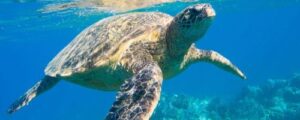One sunny day in late September 2024, I had the unforgettable experience of witnessing baby turtles hatchling on Falassarna beach (in Crete). As my boyfriend and I strolled along the shore, he noticed four tiny turtles emerging from the sand. Watching them waddle across the beach was pure magic, so, of course, I had to film their journey toward the sea.
As we stood there, amazed by the sight, questions began to pop into our heads. Was this a common nesting spot for turtles? It seemed strange for such a busy tourist beach. And with so many people around, was it safe for the turtles? My curiosity led me to the ARCHELON website, The Sea Turtle Protection Society of Greece, which has dedicated over 40 years to safeguarding these incredible creatures. One section titled “Found a nest or hatchling?” grabbed my attention. There I found clear guidance on what to do in these situations:
- Don’t dig out the nests—Check!
- Avoid touching the hatchlings—The turtles must find their way to the sea. You can help by smoothing their path and providing shade from the sun—another check!
- Report potential threats— Such as beach bars, furniture, or light pollution—to the Coast Guard before taking action. You can also contact ARCHELON at +30 6941 511 511 for guidance. Unfortunately, we didn’t inform the Coast Guard in time, but we did report our sightings to ARCHELON via their online form: https://archelon.gr/en/sporadic-nesting

Later that day, we were excited to tell the waiter at the restaurant about our discovery, but his response surprised us: “Don’t say it too loud—we don’t want to lose our permit”. I felt conflicted. Part of me was frustrated that he seemed more concerned about continuing business as usual than about the turtles, but I also understood his worry about losing income.
This sparked a long conversation between my boyfriend and me about how we can organize tourism to better coexist with nature. How can we ensure that visitors can continue to enjoy Crete’s stunning beaches while allowing the tourism industry to carry on and ensuring that sea turtles can nest safely and abundantly? And finding that balance seemed even more important since the tourist season in Crete overlaps with the turtles’ nesting and hatching period from May to September.
This discussion inspired me to dive deeper into the subject, discovering that beaches with significant breeding populations are part of the European ecological network Natura 2000. In Crete, notable examples include the beaches of Chania, Rethymno, and Messara Bay, where special measures are in place to protect the habitats of sea turtles.
In these designated nesting areas, municipalities allow local businesses to use the beach, as long as they adhere to specific protection measures during the nesting and hatching season. These include:
- Removing beach furniture (sunbeds) after sunset
- Conducting beach clean-ups without heavy machinery
- Prohibiting vehicles on the beach
- Reducing light pollution
- Banning night parties on nesting beaches
That’s good to hear. However, it made me think about the sporadic nesting that occurs on unmonitored beaches, like the one I saw at Falassarna Beach. Are those nests also at risk of disturbance from human activities?
This question led me to reflect on Falassarna Beach, where I began to mentally scan the surroundings and determine how safe they were for the turtles. I opened Google Maps to gather clues about the beach’s environment and determine its suitability—or lack thereof—for turtle nesting. I took a screenshot on my phone and marked the exact spot where the turtles nested, which you can see in the photo below.

I must say, I was quite impressed with how the Cretans have developed the area. Although it may not have been part of a formal plan to protect the turtles, the development has effectively balanced the needs of tourists and wildlife. Visitors enjoy the stunning beach, the tourism industry flourishes, and sea turtles can nest with minimal disturbance.
This balance is evident in the positioning of the restaurants, which are set back 100 to 150 meters from the water, helping to reduce light pollution. The open sandy areas between the seating provide ample space for turtles to find suitable nesting spots. Plus, these areas are perfect for budget-conscious tourists like me who prefer to relax without spending 20 euros a day on a beach lounge chair. And that’s just for a seat in the back row! If you want to be in front of the sea’s stunning show, you should be ready to pay up to 50 euros. Seems a little over the top, right? But I’m going off track—let’s get back to Falassarna Beach! As you can also see, wooden pathways connect the restaurants to the beach, minimizing the impact visitors have on the surrounding nature. This setup not only protects the nesting areas from tourists, it also makes it easier for waiters to serve drinks to customers on the beach with bikes. As I mentioned earlier, this may not have been part of a formal plan in favor of the turtles, but it works.

However, even though we’re far from the concrete jungle of the Mediterranean coast, I couldn’t help but feel annoyed by the front-row sunbeds (yes, the ones that cost 50 euros per day), which are permanently fixed in place. Can you imagine the hassle of moving these big, heavy structures back 100 meters every night? No staff would want to deal with that!


Unlike the protected nesting beaches on the north side of the island, where sea turtles come ashore almost every night during the nesting season, the businesses at quieter Falassarna aren’t required to remove the beach lounge chairs. While they’re not at fault, it does raise questions about whether those sunbeds truly belong there.
I found myself wondering why this situation bothered me so much. After all, it was fully sanctioned by the measures in place, and the turtles had ample space to nest, which seemed adequate. So why did it still bother me? Perhaps it was the futility of lounging on those oversized sunbeds that struck me as excessive. This feeling only intensified when I considered the stark contrast to the conditions faced by refugees in Samos, which added to my frustration.
To bring the widening gap between extreme luxury and severe poverty back to a more humane and decent level, we need to explore other creative, more equitable solutions for generating income that can benefit the community as a whole, rather than just a select few.
Additionally, with climate change on the horizon, rising sea levels and higher temperatures are pushing these creatures to look for new nesting sites, which means we need to prepare our beaches to accommodate them.
And with the incredible design talent available today, I’m confident we can create portable sunbeds that everyone will appreciate.

Despite the challenges, there is hope. This year, Greece has witnessed a record number of sea turtle nests, a testament to the remarkable progress made in conservation. This success is the result of 40 years of dedicated work, proving that when we prioritize the well-being of our communities and the environment, positive change is possible.
Building on this momentum, efforts are now underway to explore how these nesting and hatching events can be transformed into a sustainable revenue model. “Imagine witnessing the reproductive cycle of loggerhead turtles along these shores,” says ARCHELON. “It’s not just a memorable experience; it’s a transformative one that inspires action.”
For me, it was exactly that—transformative. Watching the turtles was the highlight of my trip, a moment that will stay with me forever. The magic of that experience, coupled with the stunning shades of blue unique to these waters, left an indelible mark on me.
Later that evening, still buzzing with excitement, we shared our story with the scooter rental staff and the hotel receptionist. As they watched the video, I watched their eyes widen with enthusiasm. They all expressed a desire to witness this wonder themselves one day.
“Our goal is to turn tourists into ambassadors”, ARCHELON explains. “We want them to return home not only with memories but with a commitment to protecting our marine ecosystems”. Consider me one of those ambassadors. Reflecting on my journey, I realize that the beauty of this place is more than just its stunning scenery. It reminds me of the unspoiled wonders of nature and our responsibility to preserve them, so future generations can also witness the natural cycle of life.




